

|
| DEUTSCHLAND | GERMANY |
| Bundesland: Sachsen-Anhalt | Saxony-Anhalt |
| Landkreis: Harz |
 Ilsenburg (Harz) is situated at an elevation of 260 m on the river Ilse near northern Germany's highest mountain, the Brocken (1,142 m), and the Hochharz National Park.
The first mention of the castle (Elysynaburg) dates back to 995 AD.
In 1003, the castle came in possession of the bishopric of Halberstadt and was transformed into a Benedictine monastery, which became
a cultural and economic centre of the northern Harz region. The monastery was closed in 1572 and was transformed into a residential castle again in 1609.
Throughout the centuries the economic life of the region was largely influenced by the mining and working of iron ore.
The earliest documents mentioning iron ore mining date back to the 11th and 12th century. The first furnace was built in 1546. In 1697, Czar Peter the Great
visited the ironworks. The ironworking industry began to boom in the early 19th century. Machine factories, a steel rolling mill, and iron castin facilities were set up.
Iron casting became the main industrial factor in the late 19th century. At the same time, tourism became another important factor for the town.
In 1959, Ilsenburg obtained the official status of a city. Since 1994, it also has the status of a climatic resort.
Ilsenburg (Harz) is situated at an elevation of 260 m on the river Ilse near northern Germany's highest mountain, the Brocken (1,142 m), and the Hochharz National Park.
The first mention of the castle (Elysynaburg) dates back to 995 AD.
In 1003, the castle came in possession of the bishopric of Halberstadt and was transformed into a Benedictine monastery, which became
a cultural and economic centre of the northern Harz region. The monastery was closed in 1572 and was transformed into a residential castle again in 1609.
Throughout the centuries the economic life of the region was largely influenced by the mining and working of iron ore.
The earliest documents mentioning iron ore mining date back to the 11th and 12th century. The first furnace was built in 1546. In 1697, Czar Peter the Great
visited the ironworks. The ironworking industry began to boom in the early 19th century. Machine factories, a steel rolling mill, and iron castin facilities were set up.
Iron casting became the main industrial factor in the late 19th century. At the same time, tourism became another important factor for the town.
In 1959, Ilsenburg obtained the official status of a city. Since 1994, it also has the status of a climatic resort.
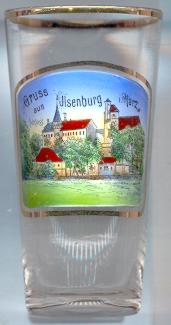
The  former Benedictine church Sankt Peter und Paul [top right] was built between 1078 and 1087.
Despite some modifications in the 16th century, the church and other former monastery buildings, especially the refectory and the chapter house of 1161–1176,
are important examples of Romanesque architecture.
former Benedictine church Sankt Peter und Paul [top right] was built between 1078 and 1087.
Despite some modifications in the 16th century, the church and other former monastery buildings, especially the refectory and the chapter house of 1161–1176,
are important examples of Romanesque architecture.
The  castle [top left] received its present form in 1862–1883 when former monastery buildings of the 12th century
were adapted as a residential castle. Today, the castle is used as a hotel.
castle [top left] received its present form in 1862–1883 when former monastery buildings of the 12th century
were adapted as a residential castle. Today, the castle is used as a hotel.
The  valley of the river Ilse [left, no. 844: bottom leftt picture] and
the
valley of the river Ilse [left, no. 844: bottom leftt picture] and
the  Ilse(n)stein [left, no. 844: bottom right picture] (474 m, 150 m above the river) are popular for hiking excursions.
The iron cross on the summit was erected after the Napoleonic Wars in 1814. The poets Johann Wolfgang von Goethe and Heinrich Heine, and the composer
Engelbert Humperdinck were inspired by this landscape (the Ilsenstein is mentioned in Humperdicks opera Hänsel und Gretel).
Ilse(n)stein [left, no. 844: bottom right picture] (474 m, 150 m above the river) are popular for hiking excursions.
The iron cross on the summit was erected after the Napoleonic Wars in 1814. The poets Johann Wolfgang von Goethe and Heinrich Heine, and the composer
Engelbert Humperdinck were inspired by this landscape (the Ilsenstein is mentioned in Humperdicks opera Hänsel und Gretel).
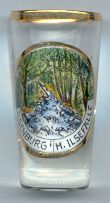
The beauty of the  Ilse cataracts (Ilsefälle) [left] was described by
Heinrich Heine in his book Harzreise (1824).
Ilse cataracts (Ilsefälle) [left] was described by
Heinrich Heine in his book Harzreise (1824).
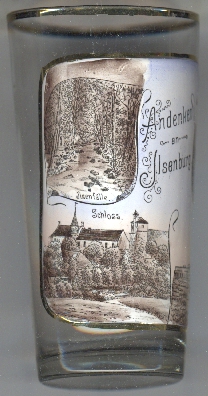
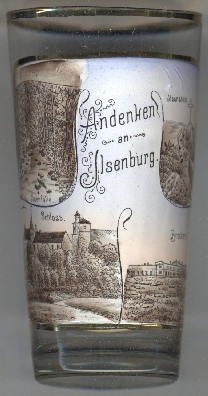
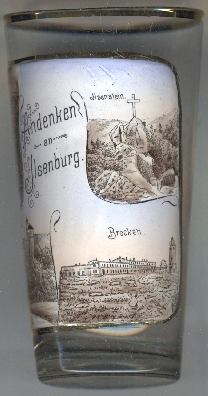 The pictures on glass no. 4299 [near left] show views of the Ilse cataracts [top left inset],
Ilsenburg castle [bottom left picture], and the Ilsenstein [top right inset], all described above.
The pictures on glass no. 4299 [near left] show views of the Ilse cataracts [top left inset],
Ilsenburg castle [bottom left picture], and the Ilsenstein [top right inset], all described above.
The bottom right picture sows a view of the Brocken hotel on the Brocken mountain, located about 5 km southwest
of Ilsenburg (Harz).
![[scale]](lineal.jpg)